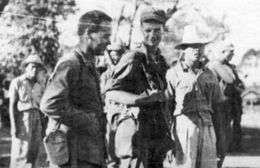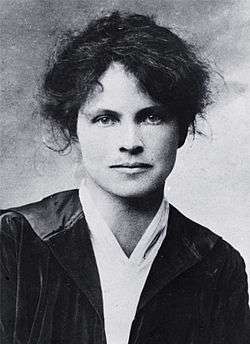Dorothy Canfield Fisher
| Dorothy Canfield Fisher | |
|---|---|
|
Canfield Fisher as a young woman. | |
| Born |
Dorothea Frances Canfield February 17, 1879 Lawrence, Kansas, US |
| Died |
November 9, 1958 (aged 79) Arlington, Vermont |
| Nationality | American |
| Other names | Dorothea Frances Canfield |
| Occupation | Writer, educator |
| Known for | Montessori method; adult education; Dorothy Canfield Fisher Children's Book Award |
Dorothy Canfield Fisher (February 17, 1879 – November 9, 1958) was an educational reformer, social activist, and best-selling American author in the early decades of the twentieth century. She strongly supported women's rights, racial equality, and lifelong education. Eleanor Roosevelt named her one of the ten most influential women in the United States.[1] In addition to bringing the Montessori method of child-rearing to the U.S., she presided over the country's first adult education program and shaped literary tastes by serving as a member of the Book of the Month Club selection committee from 1925 to 1951.
Biography
Dorothea Frances Canfield – named for Dorothea Brooke of the novel Middlemarch[2] – was born on February 17, 1879, in Lawrence, Kansas, to James Hulme Canfield and Flavia Camp, an artist and writer.[3][4] From 1877 to 1891 her father was a University of Kansas professor with responsibility for various historical studies, and finally president of the National Education Association. Later he was chancellor of the University of Nebraska, president of Ohio State University, and librarian at Columbia University.[5] Canfield Fisher is most closely associated with Vermont, where she and her mother made trips to the family home[5] and where she spent her adult life. Vermont also served as the setting for many of her books.
In 1899 Canfield received a B.A. from Ohio State University, where she was a member of Kappa Kappa Gamma. She went on to study Romance languages at University of Paris and Columbia University (where her father was Librarian from 1899)[5] and earned a doctoral degree from Columbia[3] with the dissertation Corneille and Racine in English (1904). With George Rice Carpenter from Columbia she co-wrote English Rhetoric and Composition (1906). She was the first woman to receive an honorary degree from Dartmouth College and received others from the University of Nebraska, Middlebury, Swarthmore, Smith, Williams, Ohio State University, and the University of Vermont.[6]
She married John Redwood Fisher in 1907, and they had two children, a daughter, Sally, and a son, Jimmy.[3]
In 1911 Canfield Fisher visited the "children's houses" in Rome established by Maria Montessori. Much impressed, she took up the cause of bringing the method back to America, translating Montessori's book into English and writing five of her own: three nonfiction and two novels.[1]
Another concern of Canfield Fisher was her war work. She followed her husband to France in 1916 during World War I and while raising her young children in Paris worked to establish a Braille press for blinded veterans.[1] She also established a convalescent home for refugee French children from the invaded areas; continuing her relief work after the war, she earned citations of appreciation from Eleanor Roosevelt, Madame Chiang Kai-shek, and the government of Denmark.[3]
Canfield Fisher died at the age of 79, in Arlington, Vermont, in 1958.[6]
Activism
Canfield Fisher engaged in social activism in many aspects of education and politics. She managed America's first adult education program. She did war-relief work in 1917 in France, establishing the Bidart Home for Children for refugees and organizing an effort to print books in Braille for blinded combat veterans. In 1919, she was appointed to the State Board of Education of Vermont to help improve rural public education. She spent years promoting education and rehabilitation/reform in prisons, especially women's prisons.
After the war, she was the head of the U.S. committee that led to the pardoning of conscientious objectors in 1921, and sponsored financial and emigration assistance to Jewish educators, professionals, and intellectuals.
After her son was killed in World War II, she arranged a fellowship at Harvard Medical School for the two Philippine surgeons who tried to save his life.
Friendships with other writers
Canfield Fisher and Willa Cather's decades-long relationship intensely revolved around their writing. Their letters, from 1899 to 1947, reveal a lasting and complicated friendship.[7]
Cather wrote a short story that may have satirized Canfield's mother, called "Flavia and Her Artists"—sparking ten years of interrupted friendship between Canfield Fisher and Cather.[8] Other writers that corresponded with Canfield Fisher included Henry Seidel Canby, Richard Wright, Heywood Broun, Witter Bynner, Isak Dinesen, and Robert Frost.
Books
Canfield Fisher spoke five languages fluently, and in addition to writing novels, short stories, memoirs, and educational works, she wrote extensively as a literary critic and translator. For tax purposes, her novels were written as "Canfield," her non-fiction as "Fisher."[1]
Her best-known work today is probably Understood Betsy, a children's book about a little orphaned girl who is sent to live with her cousins in Vermont. Though the book can be read purely for pleasure, it also describes a schoolhouse which is run much in the style of the Montessori method.[1] In all, she wrote 22 novels and 18 works of non-fiction.[6]
Novels
- Gunhild (1907) (contrasting Norwegian and American values)
- The Squirrel-Cage (1912) (the first of her treatments of marriage)
- The Bent Twig (1915)
- The Real Motive (1916).
- Fellow Captains (1916) (with Sarah N. Cleghorn).
- Understood Betsy (1917)
- Home Fires in France (1918)
- The Day of Glory (1919)
- The Brimming Cup (1921)
- Rough-Hewn (1922)
- The Home-Maker (1924) (reprinted by Persephone Books in 1999)
- Her Son's Wife (1926)
- The Deepening Stream (1930)
- Bonfire (1933)
- Seasoned Timber (1939)
Short story collections
- Hillsboro People (1915)
- The Real Motive (1916)
- Raw Material (1923)
- Made-to-Order Stories (1925)
- Four Square (1949)
- The Bedquilt and Other Stories (1997)
Non-fiction
- Corneille and Racine in England (1904) (dissertation)
- English Rhetoric and Composition (1906) – with G. R. Carpenter
- What Shall We Do Now? (with others) (1906)
- A Montessori Mother (1912)
- A Montessori Manual (1913)
- Mothers and Children 1914.
- Self-Reliance 1916.
- Life of Christ 1923 (by Giovanni Papini, freely trans. from the Italian by Dorothy Canfield Fisher)
- Why Stop Learning? (1927)
- Work: What It Has Meant to Men through the Ages (1931) (by Adriano Tilgher, trans. from the Italian by Dorothy Canfield Fisher.
- Tourists Accommodated 1932.
- Nothing Ever Happens and How It Does 1940. (with Sarah N. Cleghorn)
- Tell Me a Story 1940.
- Our Young Folks 1943.
- American Portraits 1946.
- Paul Revere and the Minute Men 1950.
- Our Independence and the Constitution 1950.
- A Fair World for All 1952.
- Vermont Tradition 1953.
- Memories of Arlington, Vermont 1957.
- And Long Remember 1959.
William Lyon Phelps comments, "All her novels are autobiographical, being written exclusively out of her own experience and observation."
Legacy
The Dorothy Canfield Fisher Children's Book Award is an award for new American children's books whose winner is chosen by the vote of child readers.[9]
A dormitory at Goddard College in Plainfield, Vermont, is named for Fisher.
Organizations
Canfield Fisher worked with the following organizations over the course of her life.
- Adult Education Association
- American Youth Commission of the American Council of Education, 1936–1940
- Book of the Month Club Committee of Selection, 1926 until 1951
- Honorary Committee of the Women's International League for Peace and Freedom, 1935
- The Lighthouse Organization, 1917
- National Institute of Arts and Letters, 1931
- Vermont Board of Education, 1921
Children
Sally was born in 1909.[3] When her mother died in 1958, Mrs. John Paul Scott lived in Bar Harbor, Maine, and had written 18 children's books as Sally Scott.[lower-alpha 1] Canfield Fisher's granddaughter Vivian Scott was also writing children's books[10] and at least one had been published, evidently.[lower-alpha 1]

James (Jimmy) was born in 1913[3] and became a surgeon and captain in the U.S. Army during World War II. He served with the Alamo Scouts for three months at the end of 1944, following which he was attached to a Ranger unit which carried out the raid to free POWs imprisoned at Cabanatuan in the Philippines.
The raid at Cabanatuan was a great success, with the Rangers suffering only two fatalities. Captain Fisher was one, mortally wounded by a mortar shell. As he lay dying the next day, his last words were "Did we get them all out?" He died on Luzon, January 31, 1945.[10]
Notes
- 1 2 See Sally Scott at Library of Congress Authorities, with 25 catalog records. Unfortunately Sally Scott is not identified, or authorized in the sense of authority control, by the Library. The name is partly undifferentiated; the 25 hits may be records of works created by more than one Sally Scott. Evidently they are 21 US publications 1943–1963 created by writer Sally Scott and an illustrator (16 with Beth Krush); 4 UK publications 1981–1987 created by writer-illustrator Sally Scott, one with another writer.
See also Works by or about Sally Scott in libraries (WorldCat catalog). Evidently the first-listed work is by another Sally Scott.
Vivian Scott is another undifferentiated name, credited by 3 records in the catalog as of February 2015. One of them is for a children's picture book presumably created by Fisher's daughter Vivian Scott: The Potted Witch (Harcourt, 1957).
References
- 1 2 3 4 5 Wright, Elizabeth J (2007). "Home Economics: Children, Consumption, and Montessori Education in Dorothy Canfield Fisher's Understood Betsy". Children's Literature Association Quarterly 32 (3): 217–230. doi:10.1353/chq.2007.0045.
- ↑ Ehrhardt, Julia (2004), "Tourists accommodated, with reservations", Writers of Conviction : The Personal Politics of Zona Gale, Dorothy Canfield Fisher, Rose Wilder Lane, and Josephine Herbst, Columbia, MO: University of Missouri Press
- 1 2 3 4 5 6 "Dorothy Canfield Collection". Finding Aids. University of Vermont Libraries. 1998. Retrieved 2012-12-05.
- ↑ "Major Authors and Illustrators for Children and Young Adults". Biography in Context. Gale. 2002. Retrieved January 4, 2016.
- 1 2 3 "James Hulme Canfield Papers". Finding Aids. University of Vermont Libraries. Retrieved 2014-05-04.
- 1 2 3 "Biography". The Dorothy Canfield Fisher Children's Book Award. Retrieved June 2, 2010.
- ↑ Madigan, Mark J. (1990). "Willa Cather and Dorothy Canfield Fisher: Rift, Reconciliation, and One of Ours". Cather Studies 1.
- ↑ Rosowski, Susan J. (1985). "Prototypes for Willa Cather's "Flavia and Her Artists": the Canfield Connection". American Notes & Queries 23: 143–145.
- ↑ Bang-Jensen, Valerie (2010). "A Children's Choice Program: Insights into Book Selection, Social Relationships, and Reader Identity". Language Arts 87 (3): 169–176.
- 1 2 "Dorothy Canfield Fisher Dies in Vermont at 79". The Boston Globe. November 10, 1958.
Further reading
- Elizabeth Yates' The Lady from Vermont: Dorothy Canfield Fisher's Life and World. (Brattleboro: Stephen Greene Press, 1971), originally published by E.P. Dutton and Co. in 1958 as Pebble in a Pool.
- Dorothy Canfield Fisher – A Biography, by Professor Ida H. Washington (The New England Press, Inc., Shelburne, Vermont 1982)
External links
| Library resources about Dorothy Canfield Fisher |
| By Dorothy Canfield Fisher |
|---|
| Wikisource has original works written by or about: Dorothy Canfield Fisher |
- Works by Dorothy Canfield Fisher at Project Gutenberg
- Works by or about Dorothy Canfield Fisher at Internet Archive
- Works by Dorothy Canfield Fisher at LibriVox (public domain audiobooks)

- Inventory of the Dorothy Canfield Collection (finding aid) at Special Collections, University of Vermont Libraries – with biography
- Dorothy Canfield Fisher at Library of Congress Authorities, with 116 catalog records
|
